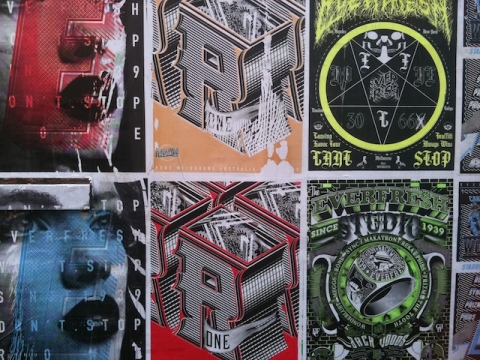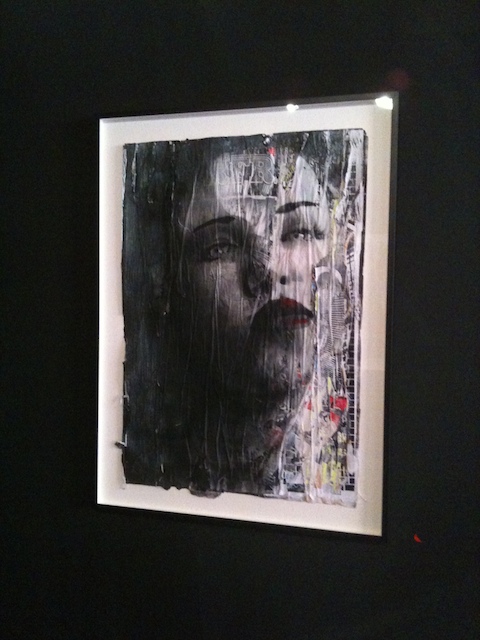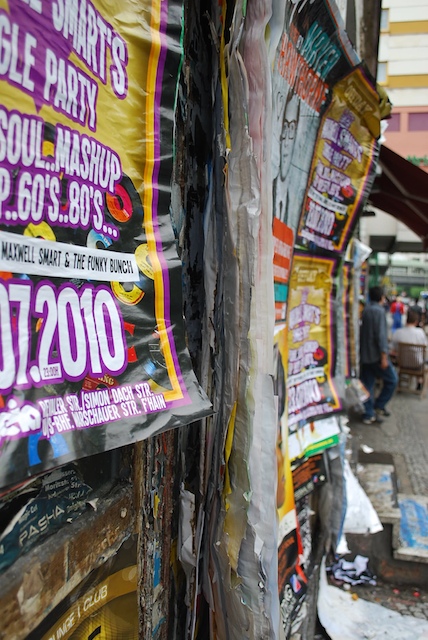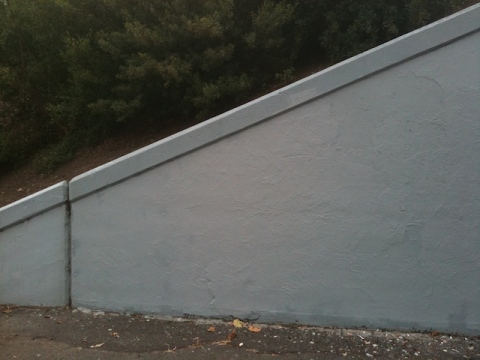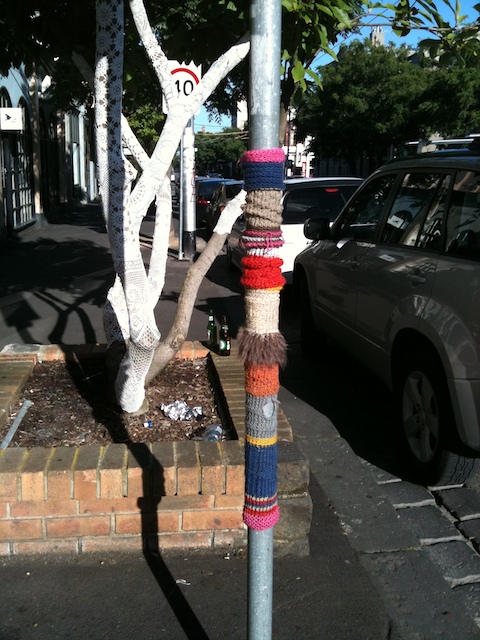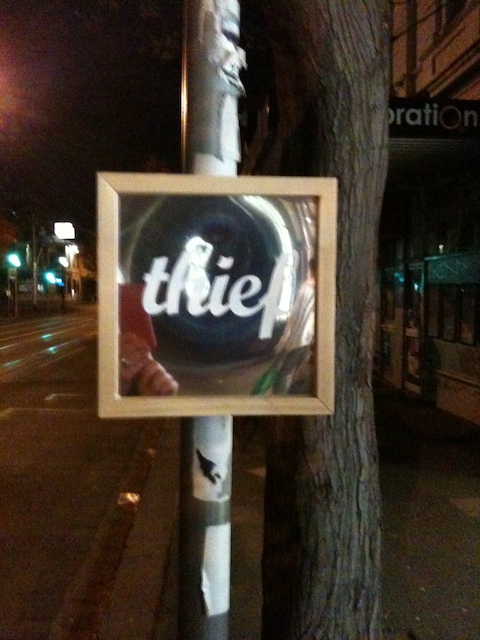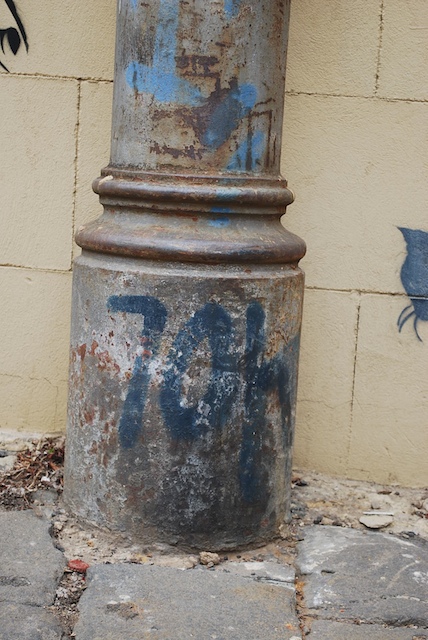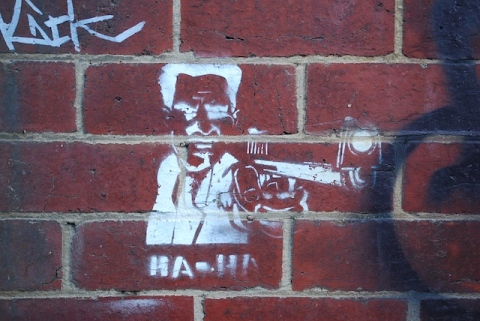Archive for the ‘Fitzroy’ Tag
R.I.P. Dick Nose
If you live in inner-city Melbourne, you’ll have grown accustomed over the last few years to seeing ‘Dick Nose’ or ‘DN’. These words and initials have been written repetitively, obsessively, on walls, door frames, tram stops, bins – any and every urban surface. Sometimes dozens or even hundreds would appear over the course of a night’s bombing.
A couple of weeks ago, the walls of Fitzroy were covered with the words ‘R.I.P. Dick Nose’, to mark the death of an individual who has, over the last few years, made such an impact on the surfaces of the city.
No doubt many did not appreciate his work. No doubt it’s possible to criticise the aesthetic of his tagging as lacking any skill, driven instead by the bomber’s desire for quantity over quality, acreage over calligraphy. No doubt many were irritated by his repeated writing on house walls and fences, causing residents who might not be fans of graffiti bombing to spend many hours painting out his work. Irrespective of such criticisms, Dick Nose was a distinctive part of inner-city Melbourne, marking the surfaces of the city in his own way: not a ‘pretty’ or easy to like part of ‘street art’, but a significant one nonetheless, and his death is a sad conclusion to one form of urban intervention.
From street to gallery and back again…
Instead of making it to opening nights, recently I’ve been lucky if I’ve made it to the last day of an exhibition…. Today I finally got to see Rone’s solo show, L’Inconnue de la Rue, at Backwoods Gallery in Collingwood, Melbourne.
Rone has been a really important figure in the Melbourne street art scene for a long time now. His collaborative work with Meggs and as part of Everfresh has contributed enormously to the streetscapes around Fitzroy and Collingwood. So it’s great to see him having a solo show (and a hugely successful one at that, with all works sold even before opening night). You can find pictures from the opening night hereand read more about the show on the Everfresh site here.
To coincide with the show, Rone put up some street pieces at one of his favourite sites, just off Brunswick Street (and I know some other local bloggers have been complaining recently that many artists don’t put up street work except when they have a show on – so that the street works function as a kind of advertising for the show – but I don’t think anyone could ever seriously lay that charge at the feet of any of the Everfresh members):
These new street works have a bit of a Warhol-ish feel to them, and seem to me to work in this space in a really satisfying way. I had imagined that the gallery pieces would be very similar to these, and they are, in some ways, but Rone has worked the gallery images to a new level of complexity:
The images are constructed through multiple layers of printed posters, which Rone has then ripped and torn back. The images have depth, just as walls on the street build up layers of posters, flyers, stickers and so on:
They also made me think of how sometimes street artworks are torn by cleaning crews, or by acquisitive fans, trying to take a work from public space for themselves. Like this remnant of a Swoon paste-up, forlornly clinging to a wall, the main body of the artwork torn down:
Just as a fragment of Swoon’s subject gazes out from the wall, so do the women in Rone’s images gaze out from the layers of ripped posters – the textures and experiences of the street transported into the gallery.
‘Be free’: but not for long….
I recently posted here about a number of artworks around Fitzroy and Clifton Hill featuring a figure throwing playing cards into the air, accompanied by the text ‘be free’.
As part of that post, I included a photograph of a very fresh looking ‘Be free’ artwork, at the entrance to an underpass in Clifton Hill, and on the day that I photographed it, the council graffiti removal van was parked nearby: I commented that I hoped it was not there to paint over this artwork.
Well, it wasn’t, not that day at least.
‘Be free’ stayed at the entrance to the overpass, and attracted some tagging, which then attracted some commentary of its own:
I’m indebted to Lorraine, a reader of this blog, who sent me this photograph, commenting to me in the email, ‘Not erased as you feared but tagged. It somehow works.’
Indeed, the placement of the tag somehow connects with the image, even though it covers over many of those gorgeous playing cards. One passerby felt perhaps that the tag did not work well with ‘Be free’, and wrote bluntly ‘this tag is brainless’ next to it – so that the site became a series of layers of significations.
But not for long. Lorraine emailed me this today, having taken it three days ago. Opening the email and viewing the photograph was a strange experience for me, because I had already walked past the underpass this morning, to find this:
Blankness. Fresh paint, no doubt applied by an assiduous graffiti removal van.
Was it the presence of the tag and the subsequent commentary on the tag that attracted the attention of the graffiti removalists? Or were the artwork’s days numbered, as testified by the presence of the graffiti removal van two weeks ago – perhaps it was just working its way around the locality and was always going to paint over ‘Be free’, no matter whether it was tagged or not.
I can’t help but feel sad for its disappearance. It fitted the site so perfectly. It must have made many people smile – those playing cards! Magnificent composition. I hope that more are being affixed to a wall somewhere very soon.
New discoveries…
I’ve seen a paste-up of a delicate and evocative drawing several times around Fitzroy recently:
I didn’t know who the artist was, although it seemed from the drawing that it might be signed ‘Kaff-eine’ (inscribed on the little fox).
Last week, I received one of those emails from WordPress telling me that someone had subscribed to this blog (always nice to hear). The subscriber had a URL, which I clicked on. It turns out that the susbcriber is none other than Kaff-eine, and the link took me to this site, on which you can see lots of examples of Kaff-eine’s work.
So, thanks, Kaff-eine, for subscribing, and thanks also for making such fantastic drawings and paste-ups, which bring the atmosphere of a fairytale or fable into the spaces of the city….
Textile textures….
I was out walking with friends the other evening, and on Gertrude Street in Fitzroy I came across two beautiful interventions in public space – really two of the most delightful and pleasurable pieces of work I have seen in a long time.
I’ve found it hard to put a name to what kind of work they are: I suppose the name that would most obviously be given to them would be ‘yarn-bombing’, but seeing these works made me realise how little I like that term and how inadequate I think it is for the grace and delicacy involved in these works, in which knitted woollen shapes are fastened around a grey metal pole, and white lace is fitted closely to the narrow trunks of nearby trees. As you can see, part of the visual pleasure in the works is how they make the man-made pole and the natural tree trunks somehow akin to each other, linked by their verticality and their new roles as part of the street sculpture.
‘Yarn-bombing’ draws an analogy with tagging, whereby a writer puts up their tag so often that a city or a suburb is ‘bombed’ by the tag. Somehow that just doesn’t seem right with these sorts of works, and I think a new name needs to be found: textile sculptures? fabric sculptures? The works use a textile, such as wool or cotton, to make shapes in public space, but they also work with the shapes already present: in these images they are wrapped around the trees and around the pole supporting a street sign. To that extent the work is dependent on transforming something into part of the sculpture, so that a pole is no longer just a pole, and a group of trees becomes part of a delicate network of lace.
Encountering these works really was a delight: we all exclaimed out loud and stood and admired them for several minutes. It is an incomparable example of the potential for street art to intercede in public space in a manner that brings sheer joy to the spectator. Maybe others might walk past feeling simply puzzled as to their presence or thinking dismissive thoughts about the purpose of the activity. For me, it demonstrates the care and effort that can be involved in street art. How long did it take to make these works? How did the artist(s) select the site? And it demonstrates that street art still has the capacity to create moments of delight in the midst of the city.
‘Where is Mona? She’s long gone…’
So sings Nick Cave, in the opening line of the track ‘Fifteen Feet of Pure White Snow’ on No More Shall We Part.
And this line jumped into my head this morning when I walked down a street in Fitzroy to find the Graffiti Removal guys busily washing a wall that I had photographed and posted about only last night (see the previous entry).
One of my favourite recent works, which seems to be signed ‘Mona’, was being buffed.
So if you are walking through the streets of Fitzroy looking for the artworks of Mona, as far as this partoicular site is concerned, ‘she’s long gone’, and what’s left is this:
I guess this must be one of those issues of personal taste. All the other recently added works nearby seemed to be still there; it’s only the ones on this house that have been buffed. Did the residents ask the council to remove it? Or did the council decide that this house should be buffed and not the others? The latter seems unlikely so I’m assuming it’s been done at the residents’ request.
To my mind, this raises lots of interesting issues. In my view, the residents are completely entitled to remove the work if they wish. If an artist puts work up without permission, then there’s always the risk that the person living or working inside the property may not appreciate the art, and wishes to remove it. It’s like if you give someone what you think is a cool T shirt or interesting book for their birthday, but they then ask if they can exchange it for something else – maybe you wish they wouldn’t, but hey, people are entitled to some autonomy about what they read and wear. Same with street art, I guess. If you don’t like it, I guess you can remove it (although many wish that removal wouldn’t happen quite so often or quite so speedily).
But the problem is that what’s left here really don’t look great, and so this raises the question of the technologies of graffiti removal. It’s like painting out graffiti but leaving a mismatched square of paint that just looks odd, or blasting off bill posters and leaving tattered strands of paper hanging from the wall. All of these techniques seem to be acceptable to many people, so it makes me wonder how aesthetics are being operationalised, such that blurry lines of faded paint, tattered paper or sloppily rollered paint looks ‘OK’ to those making the decisions about removal (whether these are council workers or residents). Perhaps these individuals would say that the ultimate solution is for artists not to put up work in the first place, thus obviating the need for removal, in all its imperfections.
I don’t agree. I think that it would be far more useful to have a debate about the aesthetics of the street, in which the effects of removal can be compared to the process of leaving a piece to weather and fade, or in which people can learn to appreciate that some streets are going to be modified in various ways as part of the culture of an area or a city, and in which artists can learn what types of image will work best on different kinds of surface…. I’d like to take part in such a debate, and I think others would too.
ADDENDUM:
By coincidence, Art of the State has a post about some magical stuff being done in London by the Toasters, in which they adapt those painted-out shapes and make them into new pieces of art…
ADDENDUM 2: Take a look at the link in the comment by Seldom which follows this entry – there’s a really interesting essay by ESPO (Steve Powers) about the pointlessness of painting over graffiti.
New works in Fitzroy….
After a lot of travelling this year, it’s good to be home, and to be here to stay for a while (except for a weekend in Canberra that’s coming up, about which more later).
And it’s wonderful to be back in Fitzroy, where a lot of activity has been taking place on the streets.
Here are some of the things I’ve seen since returning:
There’s an interesting installation piece on Smith Street, involving boxes attached to poles, with text on mirrored surfaces:
As you can see, this one reads ‘thief’; there are others which read ‘liar’ and ‘loser’. Nice stuff. Since first posting about this, Vetti (of Live in Northcote) contacted me to let me know this installation is by Nick Ilton, and Nick himself has sent me a link to a little video which provides a nice summary of the guerilla sculptures he has been placing around Melbourne in recent weeks. Check it out here.
I’ve seen a lot of fresh paste-ups, such as these, outside the Sutton Gallery on Brunswick Street:
You can find these near Alimentari, where there’s been a lot of activity:
And this is pretty striking:
It’s nice to be home.
The walls of Fitzroy: a love letter
When I first moved from England to Melbourne, in 1995, I lived in Carlton North but I spent a lot of time in Fitzroy, and I was struck by what I could see on the walls there. Not stencils (they would come later), not tags or pieces (they were on the trains, and the walls adjoining the train lines), but a kind of conversation taking place on the walls. Sometimes the conversation was between the authors of the comments, but oftentimes the addressee was me – or at least any individual who was walking, or taking the train, or driving, or sitting on the tram – any individual who happened to be looking. I saw graffiti that said: ‘subjugate thyself to the screen’; ‘this is the wrong site for the museum’; and ‘corporate whore’.
I became fascinated by the ways that these comments addressed the passer-by. Some seemed to simply express a view (for example, ‘this is the wrong site for the museum’); others seemed to be seeking an object of denunciation (for instance, ‘corporate whore’). And one day I passed by a wall, on which weeks before I had seen a piece of writing that said ‘Real Men Don’t Rape’. It had been edited, either by the original author or by another writer, and it now read ‘Dead Men Don’t Rape’. Something in that moment, which caused me to pause and think about the difference in the politics of each of the two statements, made me realise that the activity of writing on walls generated an encounter with the spectator (me, or anyone else), which can be educational, emotive, perhaps even transformative.
Over the years, the walls of Fitzroy hosted a huge range and number of statements, the majority being intensely political: ‘Refugees ain’t got fleas’; ‘Save Goolengook’ (an old-growth forest in Gippsland that was being intensely logged for woodchipping), and the myriad comments made by members of grrr, an all-women collective whose aim was to comment on and critique the narrow range of acceptable body types and identities depicted in television: ‘more fat women on tv’, ‘more dykes on tv’ and so on. (I was living in Northcote by this time, and I was delighted that one of grr’s comments, ‘more hairy women on tv’, was painted on the pavement in my street.)
After the explosion of stencilling in Melbourne from 200o onwards, the walls of Fitzroy became more known for its stencils than its political slogans – although many stencil artists used their medium for political ends, exploiting the stencil’s ability to catch the eye of a passerby, and using its combination of word and icon to provoke critical thought, as you can see in these examples:
And nowadays? Well, Fitzroy is still synonymous with the communicative and creative use of wallspace but now it’s the diversity of styles and media that is most remarkable. There are entire painted walls, such as the ‘Welcome to sunny Fitzroy’ wall by Everfresh (the subject of an earlier post on this blog). There are amazing paste-ups like these:
It’s worth taking a closer look at the details here. Rone has made each image slightly different, and has placed them under a ‘BILL POSTERS PROSECUTED’ sign:
There are plenty of tags, of course, and some of Fitzroy’s laneways have some very old tags, such as this 70k one:
And stencils: there are certainly still stencils around, and, once again, some have been there a long time:
The history of the appropriation of the walls in this area by artists has been on my mind a lot recently, because I’m now living in Fitzroy, so these walls provide the backdrop to my everyday life, and when I walk past them I get a strong sense of the layers of street art, visible and invisible (through the effects of time, weather, buffing, and other artists), that have become part of the very geography of this suburb.
And it was while I was walking home the other day that I came across this piece: a stunning work by Al Stark, wrapped around the corner of a house, intricately painted, simultaneously evocative and elusive:
It’s almost fifteen years since I came to Melbourne, and I wanted to write a love letter to the walls of Fitzroy (and the artists who have transformed them), providing me (and many others) with so much pleasure. Long may it continue.
The Everfresh wall in Fitzroy
Recently when I was reading the excellent blog by Very Nearly Almost, I came across a recent post which was celebrating some of Melbourne’s street art (which you can read here) and noticed that the Everfresh wall in Fitzroy was featured.
The post reminded me that I photographed this wall a few weeks ago, with the intention of dedicating a whole post to the amazing work of the Everfresh crew in creating this wall. So here is that post…
Everfresh will be well known to many readers of this blog, since their contribution to street art in Melbourne has been enormous. Their work, both commissioned and uncommissioned, can be seen on walls in many areas of the city (they are well represented in Hosier Lane, for example), but they are most closely associated with Fitzroy and Collingwood, and it’s in the streets of those suburbs that their works can be seen to best effect.
Everfresh are a crew of several artists (including Sync, Rone, Makatron, Reka, Meggs, and Phibs), who work as a group, solo, and in all possible combinations allowed by the group. They have evolved a very distinctive style, which, once you are familiar with it, is instantly recognisable. here’s one example, seen in a laneway in Fitzroy:

Last year, when I was in Amsterdam, I had the pleasure of looking up at a wall outside the Cafe Belgique in Gravenstraat and seeing an image that I immediately associated with Melbourne, and ‘home’:

Quite a while ago, I had heard that there was a large wall in Fitzroy that Everfresh were going to paint, outside the Black Cat nightclub. I know this wall well, in that I drove past it every day for two years, on my way to work. It was like any other wall in this semi-residential, semi-industrial area: tall, brick, occasionally tagged, occasionally billpostered. But now – now it looks quite different… I guess the painting happened during the several weeks that I was ill with the dreaded whooping cough earlier this year. At any rate, I didn’t see any of the work being carried out, but one day when I drove by – there it was: quite wonderful. ‘Welcome to sunny Fitzroy’:

The car parked next to it gives you a sense of the wall’s scale and size. The artwork that completely covers it is an intricately designed homage to Melbourne in general and Fitzroy in particular. The fact that it is painted in black-and-white (and shades of grey) gives it a startling prominence amid the naturalistic colours of the street around it. It looks like a frame from an old film, somehow transported into the everyday ‘real’ world, located as it is opposite a petrol station and a row of terraced houses. It also manages to showcase the distinctive styles of the artists who worked on it (for example, by incorporating some of their signature images within the letters that comprise the words) within the overall sense of a single coherent visual style. It’s such a huge work that it’s hard to photographically do justice to all the complexities within it, but here are some examples.
A section by Rone:
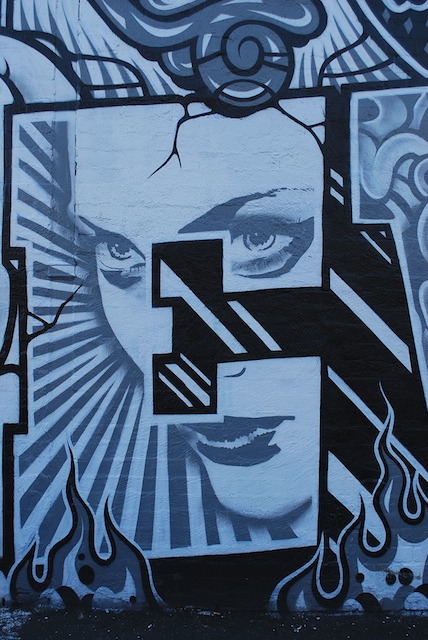
And one by Meggs:

And here are a few more, just for good measure, because the work is so great:
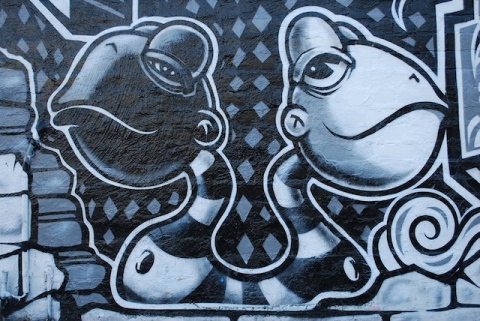


In this last image, you can really see the brickwork under the paint, a reminder that underneath there is a rather drab wall, now transformed into something which embodies the very idea and spirit of Fitzroy. Which is what Everfresh is all about, really.
 Comments (9)
Comments (9)



